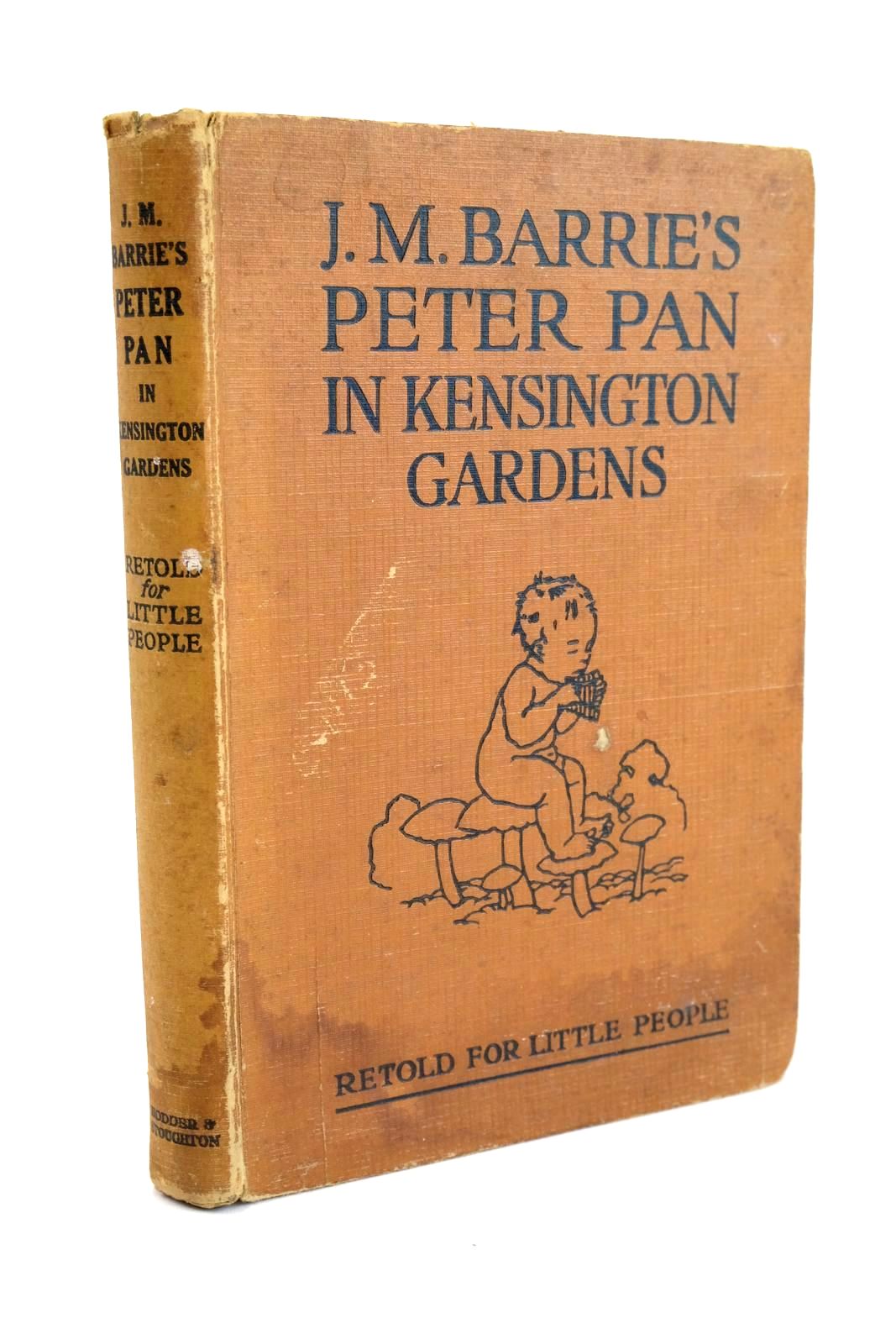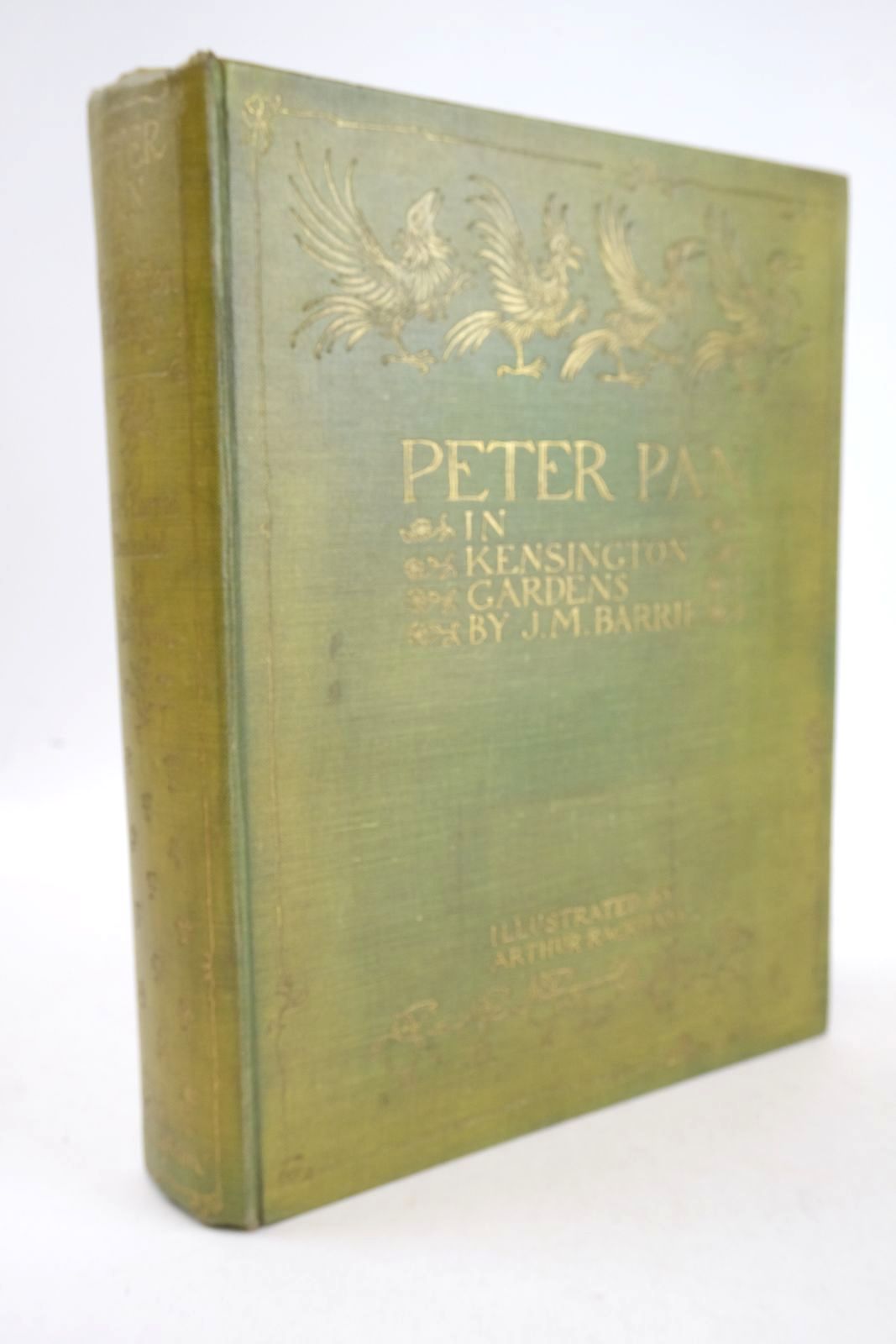Peter Pan in Kensington Gardens by J.M. Barrie
 View current stock of this title
View current stock of this title
This week, while packing up to move house – I've been going through my bookcase to see which books to give away (none so far) and I came across my facsimile copy of 'Peter Pan In Kensington Gardens' by J.M. Barrie and illustrated by Arthur Rackham.
 Originally published in 1906, Barrie utilises many chapters of 'The Little White Bird' (published in 1902), with only a few changes in text. 'The Little White Bird' was seen as a novel for adults, where Peter Pan is introduced, but 'Peter Pan in Kensington Gardens' was produced purely as a children's book, with stunning illustrations to match.
Originally published in 1906, Barrie utilises many chapters of 'The Little White Bird' (published in 1902), with only a few changes in text. 'The Little White Bird' was seen as a novel for adults, where Peter Pan is introduced, but 'Peter Pan in Kensington Gardens' was produced purely as a children's book, with stunning illustrations to match.
The book starts with 'The Grand Tour of the Gardens', for “it would be difficult to follow Peter Pan's adventures unless you are familiar with the Kensington Gardens”. This was originally chapter 13 in 'The Little White Bird'. The character 'David', a 6 year-old boy, is said to be based on George Llewellyn Davies, of the Davies family that Barrie was friendly with and encountered on his walks in Kensington Gardens, London. Written in the first person narrative style, we learn much about the Gardens and what happens there.
However, it is in chapter two of 'Peter Pan in Kensington Gardens' that we are introduced to Peter himself. For those unfamiliar with this story, it may be surprising that when we first meet Peter Pan “his age is one week”, much younger than the Peter we may think of in the stage productions and Barrie's novel 'Peter Pan and Wendy', where Peter and the Darling children adventure in Neverland. Looking at the Rackham illustrations throughout this book, it really does show Peter as an infant.
Barrie really weaves the tale and captures a child's (and adult's) imagination. We are introduced to Peter's very roots. We learn that “all children...having been birds before they were human, they are naturally a little wild during the first few weeks, and very itchy at the shoulders, where their wings used to be”.

Sadly Peter doesn't understand why the fairies and others appear to be “shunning him”, so he resolves to consult the birds. He meets old Solomon Caw, “who listened to Peter's adventures, and then told him their true meaning”. He explains that Peter is a “Poor little half-and-half” or a “Betwixt-and-Between” - not fully human and not fully bird.
Left: Soloman Caw
In the chapter 'The Thrush's Nest', Peter, with the help of Solomon Caw, proposes that the Thrushes build a boat, which was to be “simply a thrush's nest large enough to hold Peter”. The boat would be Peter's escape from the Island, down the Serpentine and out to the Gardens. Barrie puts much detail into the building of the boat and Peter's first voyage. You see glimpses of the “cocky” Peter from his later adventures to Neverland – where, during his first voyage to the Gardens, he “boldly” leaps ashore to a waiting “multitude of small people” who “gathered around him with intent to slay him”.
Through his adventures, Peter meets many other characters; one being Queen Mab. She “gives him the wish of his heart”. Peter, being the cheeky Peter we know, after discussion about the size of the wish reflected and said, “Well, then, I think I shall have two little wishes instead of one big one”.
Keeping his second wish in reserve, Peter's first wish is “to go to his mother, but with the right to return to the Gardens if he found her disappointing”.
After trying to dissuade him, the Queen gives him a warning: “I can give you the power to fly to her house, but I can't open the door for you”. Ever confident Peter replies: “The window I flew out at will be open”. This proves true and Peter visits with his mother, who is asleep in the room that he originally flew out of. However, Peter is torn and although wanting to stay and be his mother's boy again, he decides he first has to go and say goodbye to his friends in Kensington Gardens.


Above left: 'The Kensington gardens are in London, where the King lives'
Above right: 'My Lord Duke,' said the physician elatedly, 'I have the honour
to inform your excellency that your grace is in love.'
We are told that “many nights, and even months, passed” before Peter asked the fairies for his second wish. When Peter does make his second wish to “go back to mother for ever and always”, of course, most famously we know that it is too late, as “the window was closed, and there were iron bars on it, and peering inside he saw his mother sleeping peacefully with her arm around another little boy”. Sobbing, Peter returns to the Gardens.
Peter's adventures continue in the Gardens. The next chapter 'The Little House' tells us about “the only house in the whole world that the fairies have built for humans.” Maimie Mannering, a 4 year-old girl, is introduced in this chapter as she was “the famous one for whom the house was first built”.
Maimie and Peter become friends and it is Maimie who tells Peter that his ways of playing “are quite, quite wrong, and not in the least like how boys play”. It is Maimie that also teaches Peter about thimbles and kisses, because being a Betwixt-and-Between, he has forgotten a good many things that boys should know.
The final chapter is 'Peter's Goat'. Do you remember Peter's goat? It is a question asked in the chapter 'Peter Pan'. Ask your mother whether Peter Pan rode on a goat and then ask your Grandmother the same question – what answers do you get? I'll let you read the final chapter to find out the answer!!
 Editions of Peter Pan In Kensington Gardens:
Editions of Peter Pan In Kensington Gardens:
As stated earlier – the book was originally published in 1906, by Hodder & Stoughton. This edition has 50 beautiful colour plates. In the russet cloth edition, it has a frontis, with the other colour plates collected at the end of the text, mounted on heavy brown paper with captioned tissue-guards.
There was also a special vellum bound, de luxe, Limited edition (to 500 copies), Signed by Arthur Rackham, with the same amount of plates.
Another notable edition was published in 1912. This “New Edition” contains a new colour frontis and an additional 7 b/w drawings. It has green cloth covers, with gilt titles. (This is the edition that my copy is reproduced from). There was also a de luxe edition of this 1912 publication.
In years since, there have been different editions, some with the same story, but differing amounts of the original illustrations – ranging from as little as 6 colour plates to 16 or 24 plates. Others have been retold for little ones.
Please feel free to view our stock of this enchanting title!
Contributed by Joanne
(Published on 27th Feb 2015 )



